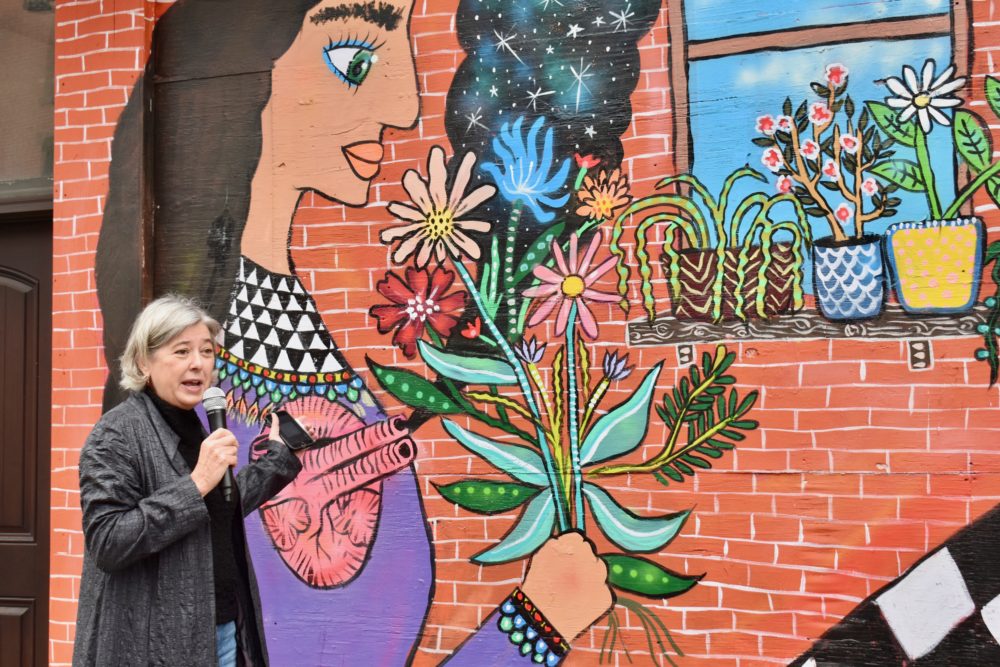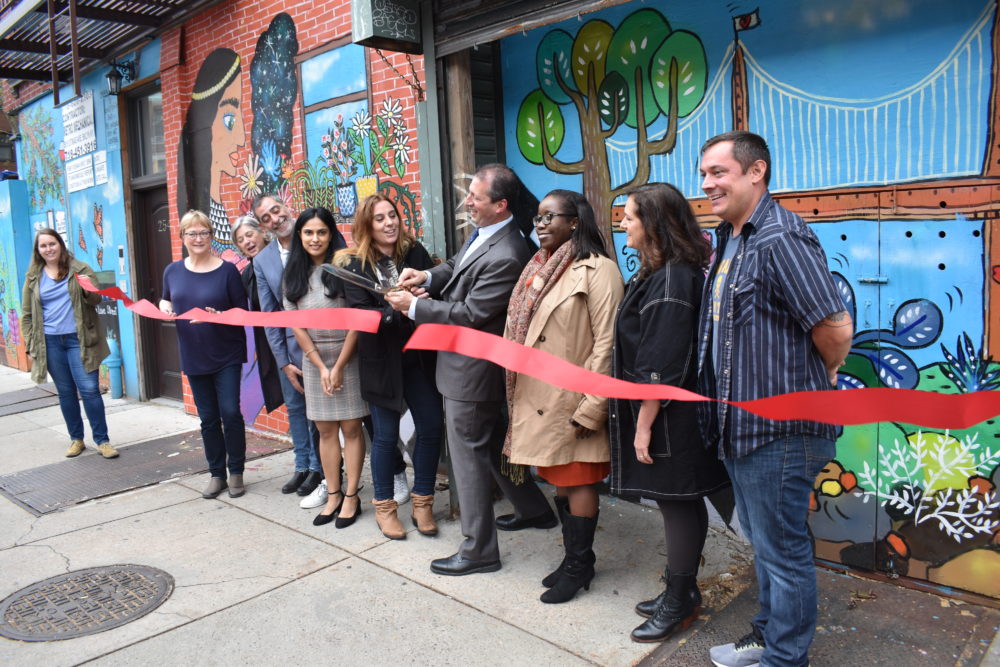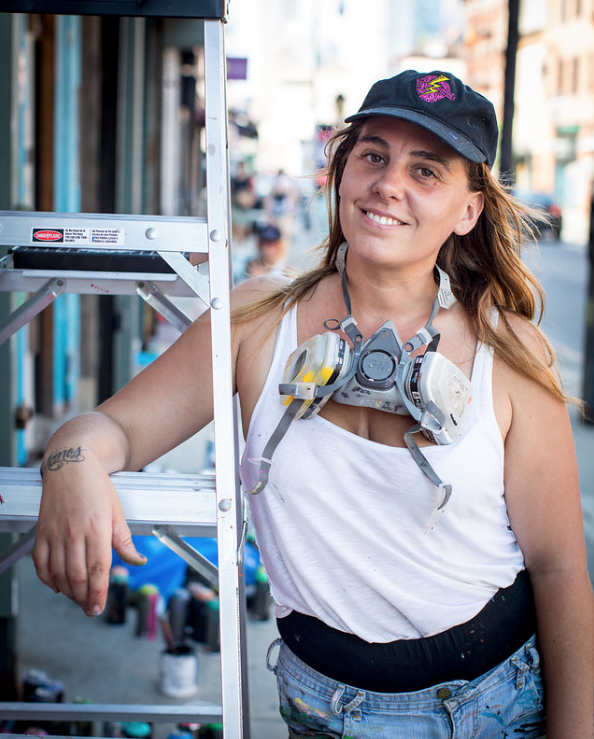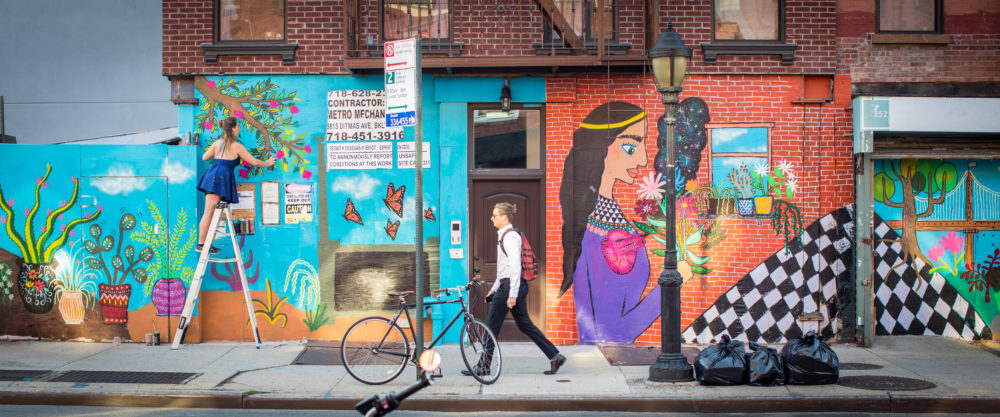Merchants Embrace Art to Give Smith Street a Boost
Unveiling a vibrant storefront mural, property owners and entrepreneurs hope to kickstart the retail corridor's revival
Heidi Cunnick, a leader of the Court-Smith BID effort, at a celebration of the mural's completion (Photo by Steve Koepp)
Smith Street needs a lift. The once-thriving restaurant row of more than a decade ago has suffered from a double whammy of economic factors in recent years—rising rents and listless foot traffic—that have left it with empty storefronts and a sometimes lackluster vibe.
But last week a jolt of energy arrived in the form of a vibrant mural spanning three empty storefronts on the block between Douglass and Degraw streets. Bursting with dreamlike scenes celebrating the borough’s history and diversity, “In Unity There Is Strength” is the work of Argentinian street artist Magda Love, who was commissioned by a nearby art center, The Invisible Dog, and a neighborhood group seeking to establish a Business Improvement District (BID) for the area.

City Council Member Brad Lander does the honors at the ribbon cutting. Said he: “People are going to enjoy it as they walk by. It animates our neighborhood, as public art does” (Photo by Steve Koepp)
“We recognize that we have an issue with these vacancies because we get these little strips of blight. So we looked for an imaginative way to break the cycle,” said Heidi Cunnick, co-chair of the steering committee for the Court-Smith BID Formation Effort, as the mural was celebrated with a ribbon-cutting. The group hopes that the creation of the mural is a persuasive demonstration of the kinds of projects a BID could undertake to brighten and promote the retail corridor, drawing in more visitors from the neighborhood and beyond.
“We can’t just depend on the community here. We need to make it a destination,” said Dawn Casale, a co-chair of the BID committee and co-owner of One Girl Cookies, which opened its Dean Street shop in 2006 and has since expanded to Dumbo and Industry City. Unlike some other Brooklyn neighborhoods, which lure visitors to a waterfront or park, she said, Smith Street lacks a particular drawing card. “We need to create something else, and our vision of that is art,” Casale said, given the still-high population of artists in the neighborhood.
In the last several years, Smith Street merchants have blamed declining pedestrian traffic for slowing revenues. Casale agrees, attributing the trend to several demographic factors beyond just the impact of e-commerce. “The makeup of the neighborhood has changed dramatically,” she said. One trend is the conversion of multi-family town houses into single-family homes, decreasing the population density, she said. Another is the increasing number of two-income families, she said, in which the parents tend to want to spend more time on activities with their kids and less time shopping.

Muralist Love strives to raise consciousness about social and environmental issues (Photo by Kathi Littwin)
The BID effort began in 2014 as a small group of volunteers, Cunnick said. Around that time, a wave of pioneering Smith Street stores and restaurants were shutting down, inspiring headlines like “The Rise and Fall of Smith Street.” Even as the overall neighborhood has become more prosperous, the proliferation of empty storefronts and the arrival of more national chain stores have put a damper on Smith Street’s DIY spirit. Court Street, meanwhile, where commercial rents are higher, has attracted a superabundance of real-estate offices.
The mission of the BID would be to promote a healthy mix of businesses by making the streets cleaner, greener, and more vibrant. A BID is a public-private partnership in which property owners within the district pay an assessment on their tax bill each year. The proposed Court-Smith BID, which would include those two streets between Pacific Street and Second Place, has an estimated annual budget of $700,000. In an example cited by the BID group, a Class A commercial property with a 20-ft. storefront would pay an annual assessment of about $1,090.
The money raised would be spent on sanitation, maintenance, beautification, community marketing and other benefits for the merchants and property owners. As the neighborhood blog Pardon Me for Asking has pointed out, the sidewalks of Court and Smith streets would benefit from more attention to trash collection.

Love (on ladder) putting the finishing touches on her mural (Photo by Kathi Littwin)
City Council Member Brad Lander, whose district includes a large portion of the proposed BID, performed the ceremonial ribbon-cutting and called for more help for small retail businesses.
“Running a small business in New York—boy, it’s got to be a labor of love to navigate all these challenges,” he told the small crowd. “We’re not doing enough as a city to show up for our small business people. That’s a loss for us as much as for them. Small commercial strips are what give our city its character.”
Zach Owens, manager of the BID program for the Small Business Services department, said the city now has 75 BIDs up and running. They represent 93,000 businesses and annual investment of $148 million. While the city provides support services for the BIDs, as does the Brooklyn Chamber of Commerce, their creation depends on enough local property owners and commercial tenants signing up to pay for them. “It has to be a community-led effort. It’s a bottom-up approach,” said Owens.
“People think we [already] have a BID but are not doing a very good job,” observed Cunnick. She and her colleagues hope their ebullient mural helps rally support for their proposal so they can get their long-proposed BID up and running.










